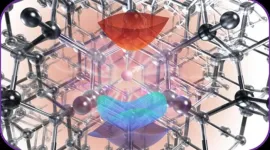(Press-News.org) Genetic analyses of an Antarctic octopus show that the West Antarctic Ice Sheet (WAIS) collapsed during the Last Interglacial ~129,000 to 116,000 years ago when temperatures were only about 1 degree Celsius (°C) warmer than preindustrial levels. The findings suggest that WAIS collapse and resultant sea-level rise could be caused by even the minimal temperature rises projected by the most optimistic climate change mitigation plans. Climate change is driving unprecedented change to Earth’s cryosphere. The West Antarctic Ice Sheet is considered particularly vulnerable to warming temperatures and may be headed towards irreversible collapse under future climate change trajectories. The ice sheet’s tipping point may lie within the current global climate targets of 1.5 to 2 °C. Total WAIS collapse would likely have devastating global ramifications. It’s estimated that WAIS collapse alone could raise the average global sea level by roughly 3 to 5 meters. Understanding how the WAIS responded to warming climate in the past, like during the Last Interglacial period, when global sea levels were 5 to 10 meters higher and temperatures were ~0.5 to 1.5 °C warmer than preindustrial levels, could help resolve the fate of the WAIS in our rapidly warming future. However, it remains unclear just how vulnerable the WAIS has been to rapid change in the past. Although a growing body of evidence seems to suggest that the WAIS may have collapsed during the Last Interglacial, current oceanographic and modeling studies have yielded conflicting and inconclusive results. Here, Sally Lau and colleagues leverage a unique and unexpected dataset to address this question – the genetic history of Turquet’s octopus (Pareledone turqueti). Modern populations of the circum-Antarctic benthic octopus found in the Weddell, Amundsen and Ross Seas are geographically isolated and separated by the WAIS. Lau et al. sequenced genome-wide single nucleotide polymorphisms in 96 octopuses collected from around the Southern Ocean. Although the populations are genetically distinct, the authors discovered some signs of admixture, revealing a historical gene flow between the Ross Sea and the Weddell Sea. Moreover, demographic modeling of these populations suggests that this admixture occurred during the Last Interglacial. Lau et al. argue that these persistent and historic signals of gene flow could only be possible if the two seas were connected by an interior open waterway where the WAIS now sits grounded below sea level, suggesting complete WAIS collapse during the Last Interglacial. “Whether or not this analysis withstands further scrutiny and the test of time, the implications of this result pose some intriguing questions, including whether this history will be repeated, given Earth’s current temperature trajectory,” write Andrea Dutton and Rob DeConto in a related Perspective.
END
Octopus DNA reveals West Antarctic Ice Sheet collapse during Last Interglacial
2023-12-21
ELSE PRESS RELEASES FROM THIS DATE:
Can cryptocurrencies be legal tender? A case study from El Salvador
2023-12-21
In El Salvador, preference for cash and privacy fears deterred the widespread adoption of Bitcoin as an everyday currency, researchers report. The findings suggest that policies incentivizing cryptocurrency adoption as legal tender will likely fail unless populations are financially literate and already trust digital currencies. The introduction of digital currencies is one of the most important developments in monetary economics in the last decade. Unlike traditional digital currencies, which rely on central authorities such as governments or banks governed by regulations ...
Researchers map how measles virus spreads in human brain
2023-12-21
ROCHESTER, Minn. — Mayo Clinic researchers mapped how the measles virus mutated and spread in the brain of a person who succumbed to a rare, lethal brain disease. New cases of this disease, which is a complication of the measles virus, may occur as measles reemerges among the unvaccinated, say researchers.
Using the latest tools in genetic sequencing, researchers at Mayo Clinic reconstructed how a collective of viral genomes colonized a human brain. The virus acquired distinct mutations that drove the spread of the virus from the frontal cortex outward.
"Our study provides compelling data that ...
Organic compounds in asteroids formed in colder regions of space: study
2023-12-21
Analysis of organic compounds – called polycyclic aromatic hydrocarbons (PAHs) – extracted from the Ryugu asteroid and Murchison meteorite has found that certain PAHs likely formed in the cold areas of space between stars rather than in hot regions near stars as was previously thought. The findings open new possibilities for studying life beyond Earth and the chemistry of objects in space.
The only Australian members of an international research team, scientists from Curtin’s WA-Organic ...
Advanced computational tool for understanding quantum materials
2023-12-21
Researchers at the University of Chicago’s Pritzker School of Molecular Engineering (PME), Argonne National Laboratory, and the University of Modena and Reggio Emilia have developed a new computational tool to describe how the atoms within quantum materials behave when they absorb and emit light. The tool will be released as part of the open-source software package WEST, developed within the Midwest Integrated Center for Computational Materials (MICCoM) by a team led by Prof. Marco ...
Role of enzyme SMYD3 clarified in prostate cancer progression
2023-12-21
Prostate cancer is the most common cancer in men other than skin cancer, and more than 288,000 new cases are diagnosed every year, according to the American Cancer Society. The disease’s fatality rate has decreased by more than half since the 1990s, but there is still room for progress—especially in treating or preventing advanced, metastatic disease, which is much more likely to be fatal.
A new paper published in Science Advances clarifies how an enzyme called SMYD3 may be involved in prostate ...
Professor Vladimir A. Botchkarev, Boston University School of Medicine, receives Skin Ageing & Challenges Best Scientific Award 2023
2023-12-21
The Skin Ageing & Challenges 2023 conference, held in November 2023 in Lisbon, has recognized the outstanding contributions of Prof. Vladimir A. Botchkarev, a distinguished Professor of Dermatology and Co-Director at the Boston University Center for Aging Research, with the prestigious Skin Ageing & Challenges Best Scientific Award 2023. The award acknowledges Prof. Botchkarev's exceptional research in the field of skin biology and aging.
Prof. Botchkarev's award-winning work, titled "Skin Aging in Long-Lived Naked Mole-Rats: Mechanisms and Perspectives", delves into the complicated aging process of Naked Mole Rats' skin. His comprehensive ...
Save the date for the 11th World Congress on Targeting Microbiota 2024 – Revolutionizing Future Medicine
2023-12-21
Targeting Microbiota 2024: Vision, Strategies and Perspectives
The 11th Annual Congress of the International Society of Microbiota (ISM), Targeting Microbiota 2024, is scheduled on October 17-18, at Corinthia Palace Malta. Targeting Microbiota 2024 will not only present the latest advancements but also serve as a pivotal hub for sharing visionary strategies and perspectives that will redefine the landscape of medicine. The Congress promises an immersive experience, offering a dynamic platform for the exchange of ideas, insights, and the exploration of innovative approaches that will shape the future of medicine.
Save the date and ...
Location, location, location: The hidden power of intracellular neighborhoods
2023-12-21
Highlights
Messenger RNA (mRNA) is translated into proteins in the cytoplasm of cells. But rather than being a uniform “soup,” the cytoplasm is divided into multiple distinct compartments or regions.
Each region is largely responsible for translating functionally similar types of mRNA, a new MSK study finds. And the location of translation determines the amount of protein produced by the mRNA.
The movement of mRNA to specific regions is directed by their size and shape, as well as by RNA-binding protein partners.
The findings could help develop new approaches to increase ...
Better prosthetics: $3M to develop more natural robotic leg control
2023-12-21
Dec. 21, 2023
Contact: Nicole Casal Moore, 734-709-1651, ncmoore@umich.edu
Images and videos
Better prosthetics: $3M to develop more natural robotic leg control
An effort to create a control model that moves seamlessly between different activities like standing, walking and climbing stairs is renewed by the National Institutes of Health
ANN ARBOR—A smoother experience for robotic prosthetic leg users is the aim of a University of Michigan project that has received renewed support from the National Institutes of Health. The R01 grant ...
The Council of Medical Specialty Societies awards CHEST a $100,000 grant to improve diagnostic excellence in ILD
2023-12-21
Glenview, IL – The American College of Chest Physicians (CHEST) was awarded a $100,000 grant from the Council of Medical Specialty Societies (CMSS) to improve diagnostic excellence in interstitial lung disease (ILD).
The funded project, called, "'How We Do It': CHEST Experts Weigh In," aims to inform future best practices in reducing the time to diagnosis for ILDs. The activities in the series will prepare the learner to:
define symptoms and patient profiles associated with ILD;
recognize health inequities that may assist in the diagnosis of ILD;
identify the appropriate tests that may help validate a suspicion of ILD; ...



